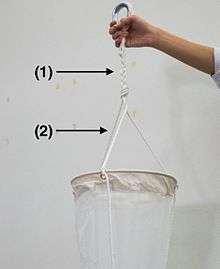Plankton net

Plankton net is an equipment used in sampling method for collecting plankton in standing water body, which includes zooplankton, phytoplankton and ichthyoplankton. This equipment consists of towing line and bridles, nylon mesh net, and cod end. A plankton net is considered as one of the oldest, simplest and inexpensive method for plankton sampling.[1] The plankton net can be used in both vertical and horizontal sampling.[1] The plankton net allows the researchers to observe both quantitative (cell density, cell colony or biomass) and qualitative ( e. g. Chlorophyll-a as a primary production of phytoplankton) analysis of planktons in the water sample from the environment.


Components
The components of plankton nets could be separated into three common parts, which are towing line and bridles, nylon mesh net and cod end.
Towing line and bridles
Towing line and bridles are the upper part of the plankton net, which are responsible for holding the plankton net. The towing lines that are connected to the triangle bridles are made of nylon rope, It can be adjust to the appropriate level that is suitable for the user.
Nylon mesh net
Nylon mesh net is the middle part of the plankton net component, which can be used to filter the plankton in the water sample according to the size of the mesh net. In addition its funnel shape provide more possibility for the net to narrow down and catch the plankton net in varied size more effectively.[2] There are various size of the mesh net varied by the target types of the microorganism that the researcher wants to collect and the condition of the water body. The narrower the mesh size is, the size of the plankton in the water sample would be smaller.
For example, in order to receive the small invertebrates, which has the size of 50 to 1500 μm, the net mesh size that the researcher should select is the mesh size between 25 to 50 μm diameter, which is sufficient to effectively filter only the target organism.[3] However, if the water condition is in eutrophic, the research suppose to use the plankton net with the size of greater than 100 μm to avoid clogging inside the net.
Cod end
Cod end is located in the lower part of the plankton net or at its end of the funnel. This part is responsible for collecting the plankton sample, as there is a collecting cylinder appearing in this part. Nearby the cylinder, there is a valve for opening and closing the cod end.
Usage
One common method for collecting plankton sample is by performing a horizontal towing method with a low speed boat. Before collecting the plankton, the plankton net should be rinsed with the sample water. The user should ensure that the cod end is completely closed by turning the valve into vertical position. Then the plankton net is hold into the water surface horizontally in the side of the boat, while the boat is moved slowly. The sampling method is done for 1.5 minutes.[4] After this time, the plankton sampling is collected from the cod end by opening the cod end or turning the valve horizontally and kept in a sample bottle.
When the sample collection method is done, the researcher can analyze the sample by using microscope to identify the types of zooplankton or phytoplankton, or cell count the plankton cell to observe the plankton cell density inside the water sources.
Historical use
John Vaughan Thompson developed a plankton net during his return voyage from Mauritius which reached the UK in 1816. Impressed by marine bioluminescence due to small crustacea he later named Sapphirina, he felt "under great obligations to this beautiful little animal, which by its splendid appearance in the water induced me to commence the use of a muslin hoop-net, which when it failed to procure me a specimen, brought up such a profusion of other marine animals altogether invisible while in the sea, as to induce a continued use of it on every favourable opportunity." He published his research in a series of six memoirs from 1828 to 1834.[5]
The second recorded use of a plankton net was by Charles Darwin on 10 January 1832, during the Beagle survey voyage. His diary included a sketch of the net, which appears to have been based on a trawl net described by John Coldstream in a letter to Darwin. It is possible that Thompson's idea had earlier been drawn to Darwin's attention by Robert Edmond Grant in Edinburgh. Darwin describes this "contrivance" as "a bag four feet deep, made of bunting, & attached to [a] semicircular bow this by lines is kept upright, & dragged behind the vessel". On the next day, he remarked that "The number of animals that the net collects is very great & fully explains the manner so many animals of a large size live so far from land. — Many of these creatures so low in the scale of nature are most exquisite in their forms & rich colours. — It creates a feeling of wonder that so much beauty should be apparently created for such little purpose."[6]
See also
References
- 1 2 Gutkowska, Agnieszka; Paturej, Ewa; Kowalska, Ewa (2012). "Qualitative and quantitative methods for sampling zooplankton in shallow coastal estuaries" (PDF). Ecohydrology & Hydrology. 12: 253–263. doi:10.2478/v10104-012-0022-2.
- ↑ Office of Marine Programs. "Plankton nets". Census of Marine Life. University of Rhode Island.
- ↑ Valdecasas, Antonio G.; Aboal, Marina; Cirujano, Santos; Iepure, Sanda; Jaume, Damia; Proctor, Heather; Velasco, Jose Luis. "Sampling continental freshwater" (PDF). The Mediterranean Institute for Advanced Studies (IMEDEA).
- ↑ Tuney, Inci; Maroulakis, Michalis. "Technical assistance for capacity building on water quality monitoring-Phytoplankton sampling methods". The European Union and the Republic of Turkey. Retrieved 23 November 2016.
- ↑ "John Vaughan Thompson (1779 - 1847)". 30 January 1927. Retrieved 20 November 2016.
- ↑ Keynes, Richard (2001), Charles Darwin's Beagle Diary, Cambridge University Press, pp. 21–22